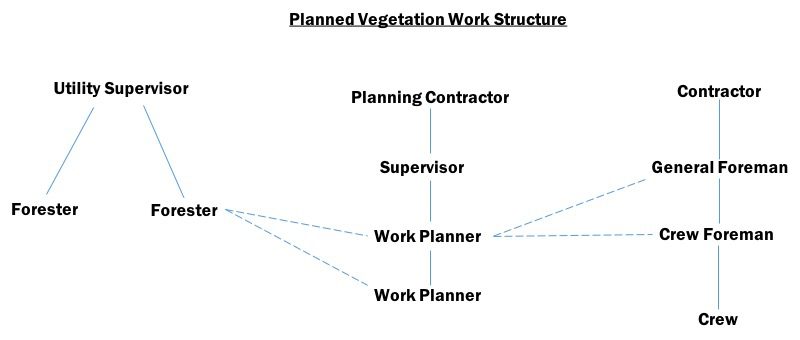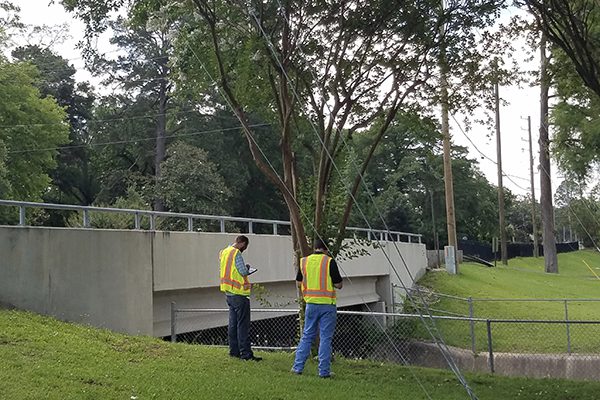A Rookie’s Guide to Vegetation Management
After forty years in the utility business, I’ve been involved with every facet of the electric utility operations from generation to transmission and even retail. What I have found is that many professionals in electric utilities do not understand what other parts of the organization do, especially vegetation management. It’s a whole part of the plan and a large part of the budget but what they hear are a whole lot of new terms like side trims, toppers, unit pricing, cycle work, hot spots, demand, fixed price, T&M….
Vegetation Management is an interesting subject as it has a language and culture all its own. Although vegetation management isn’t the mainline business of an electric utility it is a support function that is most critical to the reliable delivery of electricity. We all know that many outages, both momentary and sustained are caused by wind blowing powerlines, touching each other, shorted by a tree branch, or knocked down by a fallen tree. Electric utilities spend a lot of time and in many cases the largest part of their budget in managing the growth and trim of trees. So here is a “Rookie” primer for anyone who is interested in what the vegetation management team is up to.
What’s the process of vegetation management? It’s simple: Identify the trees that need to be cut; send people with tools to cut and clear the trees; record the date that the lines were cleared; come back and do it again when it’s needed. Sounds straight forward, but there are many ways of managing this activity.
The Process:
Let’s look at the process and see what the various influences are. Here are the basic categories in the vegetation management process:
Initiating the Work Request
Requests for tree clearance come from several areas and it depends on the type of work. There are generally two types of work, Planned and Reactive. Each type of work having variations of why the work is done and what the specific need initiated the request.
Planned
As stated earlier, the primary objective is to keep power lines clear of vegetation that can cause an interruption. One type of planned work is the maintenance of the vegetation system. This work is generally planned pruning (or trimming) and is done continuously with each year being part of a multi-year trim cycle. The trim cycle is either approved or directed by the utility commission, or in the case of municipals and coops by local management best practices.
Another approach to managing clearance work is by looking at the circuits that have the highest impact on reliability, “hot spots”, and prioritizing work in that manner. Yet another type of planned work, is that driven by new capital construction. Right of way paths must be cleared based on the new construction needs.
Reactive work
This is work that is done in response to a customer, government agency or dispatch. The most obvious type of reactive work is a trouble request from the dispatcher to clear trees before a restoration effort can begin. Another could be a customer noticing that trees are getting into the power lines. (Note: the customer relationship is a very important part of the clearance management process and we will discuss that in another blog next month).
Executing the work
There are two basic ways that utilities are structured for their vegetation work. The first is a basic vegetation management structure as shown in the chart below. A supervisor with several foresters work directly with the contractors (tree and vegetation trimming contractors) to execute the work. The supervisor is probably working on a yearly master plan which is part of that trim cycle that we discussed earlier. Foresters have walked, driven or flown (using LIDAR) the scheduled circuits and identified which areas need to be cleared. They will issue work orders to the contractors and then audit the work to make sure that it was completed properly, before the contractor gets paid.

The second structure (in the illustration below) that I’ve come across is where a planning contractor acts on behalf of the utility by planning and managing the work with the trim contractors.

These are the very basic elements of managing vegetation and line clearance. There are several other aspects that we address in another blog; some of which are customer notification and permission to access property, historical tracking of work, different contract and pricing techniques, compliance with utility commission and regulatory requirements like FAC 003. As you can see vegetation management has many components and much of it is still largely a manual, paper based operation with cabinets full of records which are not easily navigated. Of course, software can help. Looking at the information presented above the software must accommodate several business structures, varying business processes, recording and tracking of both costs and work.
GSI has been engaged in vegetation management since 2009, developing and deploying GSI Forester for electric utilities. The result is one system that facilitates every step of the process from multi-year planning through auditing completed work and updating your GIS, easily managing contractors with convenient, real-time reports and dashboards.
History and Customer
Previously we talked about some concepts that were either directly mentioned or implied. The word “history’ was never mentioned, but to know where you are in the trim cycle you need to know where and when work was previously done. We also mentioned customer and a couple of points are important here. Power lines are often on the right of way through the customer’s property. So, a customer needs to be notified and grant permission for the work. Likewise, if a customer has a complaint there needs to be history verifying that the utility did do work. The customer relationship is very sensitive and complex, especially in “canopied” communities. For an education on this issue I recommend the LinkedIn post “Less is More” by Perry Odom, City of Tallahassee Electric Utility Arborist https://www.linkedin.com/pulse/20140630133724-49180422-less-is-more
Bidding and Costing
An interesting aspect of the vegetation management business is the many ways that contracts are priced
Time and Materials- Usually this means rates are agreed to for every category of labor, equipment and materials. The contractor is just given work orders and executes at those rates.
Unit Pricing- This pricing is based upon the type of work that is done. Examples are lateral cuts, side cuts, application of growth retardants per area of measure, etc.
Firm Bid- Under this scenario prices are bid to include all material equipment and labor to clear a circuit(s) or a region. In this kind of bid the contractors may even have to do a walk (ride) down a circuit to prepare a bid.
Government Regulation
Effective July 1, 2014, The Federal Energy Regulatory Commission (FERC) mandated that all U.S. bulk energy transmission companies comply with the North American Electric Reliability Council (NERC) regulation FAC-003-2 and furthermore requires 100% inspection of all transmission corridors each year.
FAC-003-2 was born out of the cascading 2003 black out around the Great Lakes and Northeast, which was started by a vegetation flash on a bulk transmission line at First Energy. See this Wikipedia discussion https://en.wikipedia.org/wiki/Northeast_blackout_of_2003
The rule defines specific behaviors for transmission operators regarding the maintenance, reporting and penalties for non-compliance regarding vegetation management. This article in the National Law Review gives a good perspective, http://www.natlawreview.com/article/ferc-approves-new-vegetation-management-reliability-standard-issues-nopr-to-clarify
What’s the point?
Vegetation management programs are still largely manual, paper based operations with cabinets full of records which are not easily navigated. Of course, software can help. Looking at the information presented above it is clear that the software must accommodate several business structures, varying business processes, recording and tracking of both costs and work.
GSI has been engaged in this business since 2009 and the GSI Forester software can enhance any vegetation management program and covers all the scenarios described in this article.
